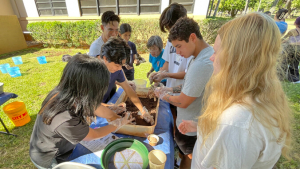
Learning mathematical concepts while helping to clean one of Hawaiʻi’s most polluted waterways was the focus of a creative University of Hawaiʻi at Mānoa lesson.
Approximately 400 students enrolled in Math 100 created about 2,000 “genki balls” from October 16 to 18, at the UH Mānoa campus. Genki balls, which get their name from the Japanese word for healthy and full of vitality, are made of nutrient and microbial-rich soil, and are designed to sink to the bottom of a waterway and slowly release beneficial microbes.

The activity was sponsored by UH Mānoa’s Department of Mathematics, in collaboration with the Genki Ala Wai project. Students worked during their class times in groups of 30 to 50.
“It’s such a good experience relating math to the real world,” UH Mānoa student Janessa Mondragon said.
“It’s just one thing to learn in a classroom with a worksheet in front of you, and it’s another thing to have an instructor like Professor Chyba bring us out here and learn with hands-on experience,” UH Mānoa student Jacktino Logoai said.
The project aligns with the course’s unit on microbiomes, incorporating lessons on scientific notation and environmental data analysis. Students learned that a teaspoon of healthy soil can contain up to one billion bacteria, putting the scale of microbial life into perspective. The students’ work will result in more than a trillion bacteria going into the Ala Wai Canal.
The Math 100 course is part of a new General Education pathway focusing on sustainability and climate change solutions.
“Actually being out here in the open, putting their hands in the mud, they’re really opening up with each other making connections and making connections with the course material to sustainability, civic engagement and helping out the environment,” Associate Professor Sarah Post said.
Following a three-week maturation period, the genki balls will be released into the Ala Wai Canal. This waterway, created in 1928, has long been considered one of Hawaiʻi‘s most polluted, collecting runoff from Mānoa and Pālolo valleys.
The students contributed toward the Genki Ala Wai project’s goal of deploying 300,000 genki balls into the Ala Wai Canal by 2026. The project is closing in on 200,000 so far.
“I am so impressed with these students that they’re interested in the environment and they are our future,” said Mary Ann Kobayashi, Genki Ala Wai project education coordinator. “So it’s so important for them to know the EM (effective microorganisms) technology and what it can do for Earth because they’re the ones that will pass the knowledge on for us.”
The Department of Mathematics is housed in UH Mānoa’s College of Natural Sciences.

